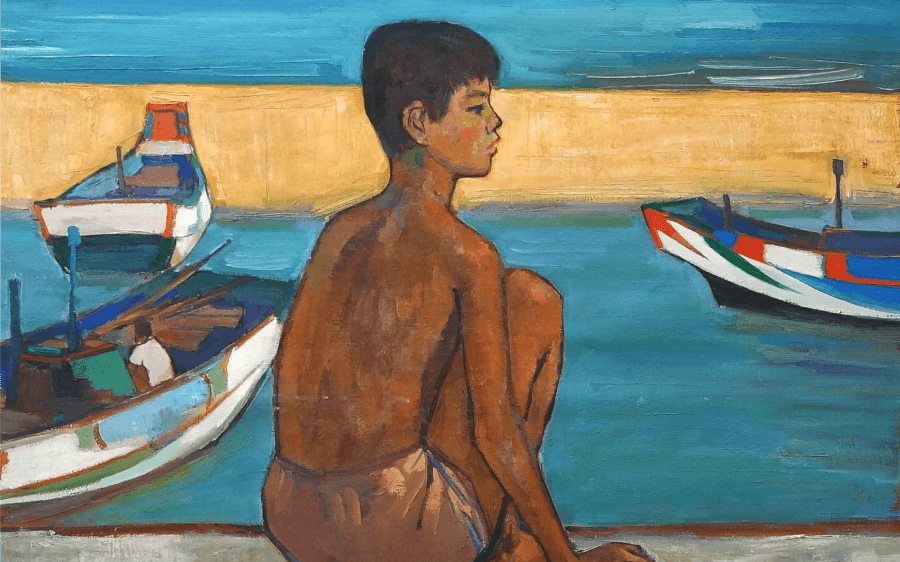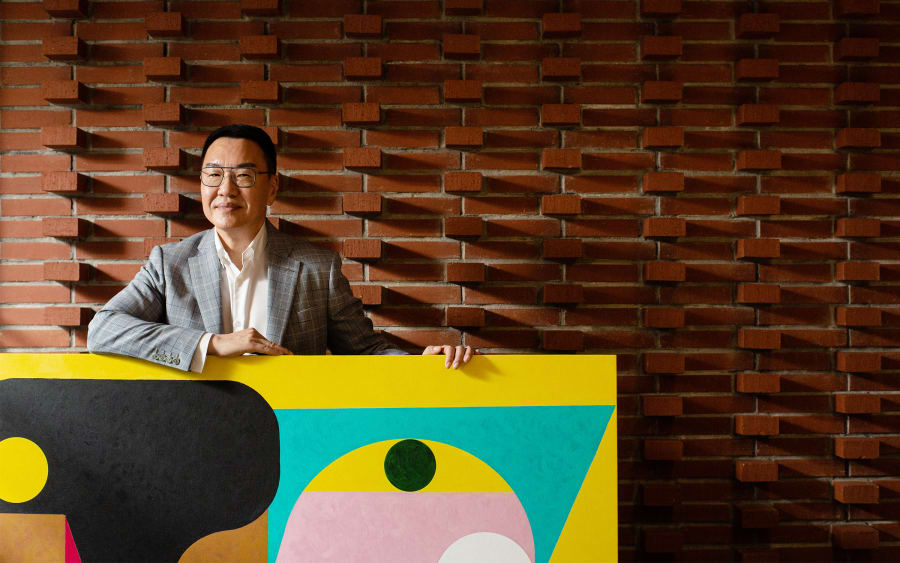‘When I was growing up, I didn’t even know what an art collector was. I never woke up and thought, “Oh, great, I’m going to be an art collector now.” It sort of gradually crept up on me. I just began going to some galleries and buying the occasional piece when I had the money. Then, before I knew it, I ran out of wall space.
I never collected for collecting’s sake, but I enjoyed the intellectual rigor around it, the reading and studying. That’s still the case today. I’ve always discovered new work at galleries. The only change is that there’s far more of everything now: galleries, artists, artworks, and art fairs. In a world where there’s a lot more supply, I think doing one’s homework is more important than ever.
A lot of the work I’ve collected has a conceptual element to it. One of the last things I bought was a painting by Wilhelm Sasnal. I first acquired his work more than 20 years ago, so I know his practice well and I know the artist personally. I was with him in Shanghai last year when he showed with the Longlati Foundation. When I’m thinking about buying a new piece, even if it’s by an artist that I’ve collected previously, I’ll still go back and do my homework. In the case of Sasnal, aside from going to see his current exhibition at Sadie Coles, I listened to a podcast he was on and I looked back at his old books; he also has a beautiful painting at Tate Modern which I went to see last week.
One of the nice things about collecting contemporary art is being able to meet the artists. I get to see great shows, with some beautiful and interesting works, but the real privilege is being able to engage, and even become friendly, with some of the artists. It’s good to hang out with people you respect.
In my Hong Kong home, I’ve got a lot of work by Masaaki Yamada. He painted from the 1950s to the early 2000s. I also have a Cici Wu piece. She shows with Empty Gallery in Hong Kong and 47 Canal in New York. She’s brilliant and a really nice person. I have ceramics, too, including a work by Eiji Uematsu who shows with Gallery 38 in Japan. There’s an early Nicolas Party painting and then a bronze and concrete sculpture by my all-time-favorite artist, Sarah Lucas. She also made a great furniture collection and I have a whole bunch of pieces. In the case of most artists, I collect in depth. I’ve got a lot of work by the African American artist Thornton Dial, who sadly is no longer with us. It’s very tactile. Another artist I love from my film collection is Derek Jarman. I increasingly enjoy living with art. In my home you can also see a lot of plants and Japanese baskets.
Over the years, I’ve acquired a significant number of moving-image works. At first, it wasn’t purposeful: I just happened to be collecting works by artists that I liked. Then, at one point, I think it was Sadie Coles who said, “Hey that feels like a nice moving-image collection.” So, we started to talk a little bit about that. Collecting moving-image work is complicated. It’s considered a sad, lonely thing. You end up buying a piece of film, a VHS tape, or a digital file, which often is not put on display – particularly if you end up with a lot of works. It just becomes tougher to actually show it all. So, the question became, “How can I make this available for myself as well as others?”
Last year, I launched the Akeroyd Collection [an online platform showcasing more than 200 moving-image works]. It’s curated and, every two or three months, we’ll put on a different show of works in my collection. We find curators or writers to select works and to write about them. The idea is that it’s building up a history and a body of critical writing.
We are working with a few institutions to lend the work to activate the collection like a video piece by Yee-I-Lann, which was shown at Singapore’s ArtScience Museum last year. We’d like to make moving-image work available to people that wouldn’t normally have access to it, including schools and colleges.
In terms of philanthropy and giving, I try to support artists, shows, or projects with which I have some sort of affiliation. If I collect an artist’s work or know them personally, it’s a lot more interesting to help with their projects. Most recently, I made a five-year gift to Tate to support acquisitions for its British Collection. I’m also sponsoring the associate curator role at the British Pavilion of the Venice Biennale, which is a ten-year commitment. The first associate curator we appointed was Emma Ridgway. She worked with Sonia Boyce, who went on to win the Golden Lion in 2022, which was a nice way to start. This year’s associate curator, Tarini Malik, will be working with John Akomfrah.
I think supporting one’s own local art scene is an obvious thing to do. It’s important to know what’s going on. When I first moved to Hong Kong in 2016, I made it my mission to get to know the public institutions, private galleries, and the artists in town. I did the same in New York, where I lived for 10 years. I’m on the board of Para Site in Hong Kong and I’m close to the team at the M+ museum where I am a committee member of the M+ International Council for Visual Art. This year, during Art Basel Hong Kong, I’m supporting Para Site’s show of Aki Sasamoto. I’ve got a lot of her work, including moving-image pieces and sculptures. She’s having a real moment. She’s got a great show at the Queens Museum in New York now – she’s fantastic!’
Payal Uttam is an independent writer and editor who divides her time between Hong Kong and Singapore. She contributes to a range of publications including Artsy, The Art Newspaper, South China Morning Post
and The Wall Street Journal.
Full-bleed image: Aki Sasamoto, Point Reflection (stil), 2023.
Published on February 26, 2024.


